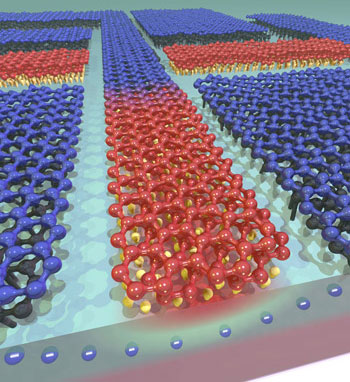| Aug 03, 2012 |
Monolithic transistors
|
|
(Nanowerk News) Physicists from Friedrich-Alexander-Universität Erlangen-Nürnberg (FAU) have developed a procedure for manufacturing integrated high-performance circuits from graphene and silicon carbide. The study has been published in the Nature Communications ("Tailoring the graphene/silicon carbide interface for monolithic wafer-scale electronics").
|
|
Graphene is a one-atom-thick layer of graphite. The material has a several unique properties and researchers around the world believe it has great potential in electronics. As early as 2009, FAU researchers devised a method for large-area production of graphene on a silicon carbide layer – however they have not yet been able to use graphene for producing high-performance transistors with excellent characteristics.
|
 |
| Graphene silicon carbide transistors.
|
|
In their latest study, Professor Heiko Weber from the Department of Applied Physics at FAU and his team have made a breakthrough to solve this limitation. Professor Weber and his research team adopted a different approach than most of their international colleagues: “We are still using a silicon carbide surface to form the graphene but our technique uses the surface as a conductive rather than insulating layer,” explains Professor Weber. “This allows us to use the properties of both materials for electronic processes.”
|
|
Thanks to intricate structures and treatment with hydrogen, the FAU physicists are able to manipulate the surface between graphene and silicon carbide to form a transistor which has excellent characteristics and is fast. “The most important innovation, however, is that the transistor consists of only two materials, which are extremely robust,” says Heiko Weber. “This technique is excellent for designing individual transistors and developing complex circuits.”
|
|
Heiko Weber and his team are already working on refining their technique as part of the Excellence Cluster ‘Engineering of Advanced Materials’ (www.eam.uni-erlangen.de) and the DFG Collaborative Research Centre (CRC) 953 at FAU.
|

